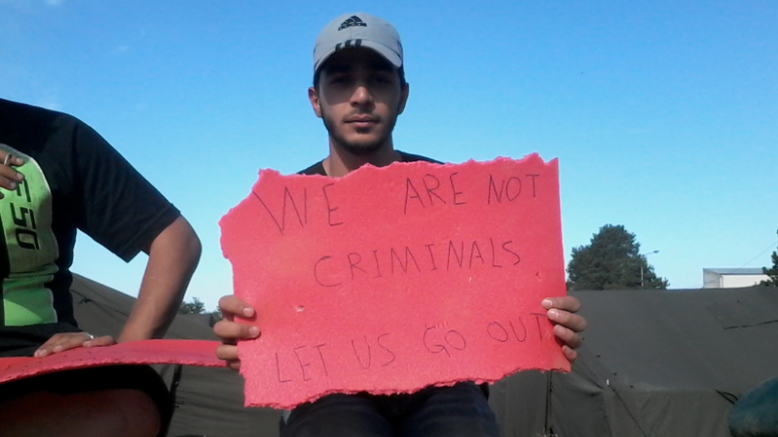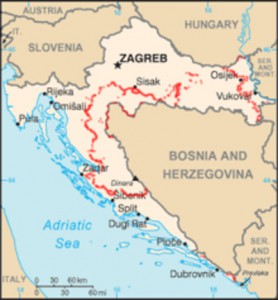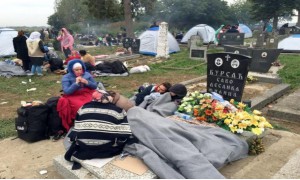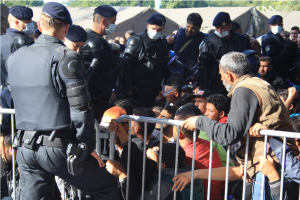Preface | Part 1 | Part 2 | Part 3 | Part 4 | Part 5 | Part 6 | Part 7
Summer of Migration – Part 5: Minefields
PDF-Download: Summer of Migration Part 5 – Minefields
The Hungarian government under Orbán had already announced in July that it would build a fence to stop people marching through the West Balkan Route, a technique previously implemented in Bulgaria.[1] Thousands of soldiers and prisoners were mobilised for constructing the fence,[2] and the crossing or damaging of the border installations were to be punished with prison charges.[3] Nevertheless, the situation remained relatively calm until Monday, 14th September, the day of the border closure in Röszke. Find below the description by Thomas Schmid, who was documenting the situation at the Serbo-Hungarian border a few days before:
At the white border stone
Some refugees seem exhausted, others appear like thoughtful Sunday walkers. Behind the first group comes a second, a third, and even a fourth is already visible. They all barely take notice of the white border stone, nor of the wooden watchtower from the communist era, sticking out from the reeds. They move on towards the North, becoming smaller and smaller, until they appear only as small dots.
Of course they know that they just passed the border between Serbia and Hungary. Just a few meters behind the border stone, a new fence with NATO wires and sharp blades sparkles to the right and to the left of the train tracks, demarcating the border between Serbia and Hungary. The gap in the fence is maintained due to the local train running between Szeged (Hungary) and Subotica (Serbia) three times per day. The fence is 175km long and was finished during the weekend, 7 weeks after the beginning of its construction. „Europe should belong to the Europeans“, Hungary’s right-wing populist prime minister Viktor Orbán had declared. It seems that he already forgot that only 26 years ago, a fence separating the East from the West was built in his country.
Between 2000 and 3000 refugees, sometimes more, currently cross the border to Hungary every day; approximately 90% of them along the single-track railway line between Szeged and Subotica. The Hungarian border guards patrolling the road in front of the fence also know about the gap. Immediately after a Hungarian television crew appears, six police officers with a German shepherd are on the spot and close the loophole. The television audience should be shown that the Hungarian police do not allow anybody to enter, that they oppose the arrival of refugees, and defend the country against those who president János Ader had recently called ‚besiegers‘.
Every school child in Hungary knows that Budapest capitulated in 1541 under the siege of the Turks, and afterwards belonged to the Ottoman Empire for one and a half centuries. The implicit message is that this time the ‚besiegers‘ – understand the Muslims, especially refugees from Syria and Afghanistan – will not win. After the TV team leaves the train tracks, the police also retreat. They know that in reality they cannot stop anybody: the fence only functions on TV screens.
The next group of refugees comes along the train tracks, moves past the border stone, towards the North. After around one and a half kilometres, a street criss-crosses the railway line. Here, the police are waiting with buses. The new arrivals are brought to the transit camp in the border town Röszke for registration.
However, those who are fingerprinted in Hungary can subsequently be returned to the country. Germany introduced a partial exception last week, deciding to stop returning people from Syria. Knowledge about the fingerprinting system and its exceptions spread among the refugees. Thus, particularly young people from Afghanistan, Pakistan and Iraq leave the train tracks a few meters before the border, disappear in the bushes and wait for an opportunity to climb over the fence to Hungary.
This is not too difficult, as the fence is less high than a person. Dirty jackets, ripped sleeping bags and blood-stained blankets are placed on top of the three layered rolls of barbed wire at multiple spots. With caution and know-how, it is possible to overcome the fence at these places without being injured by the small blades. Children slip through from below or are handed over the fence. Under the eyes and cameras of the journalists they run across the dirt road patrolled by the border guards and disappear into the forest. Most of them will probably be apprehended later during a control on the highway or in Szeged, and brought to a transit camp for registration.
Sandwiches and Internet
While the government is promoting an openly xenophobic discourse, a small group of people in Szeged is supporting the people who fled war and misery. Around 70 supporters came together via Facebook. In their wooden barrack, they prepare sandwiches and provide free access to the internet. And whenever a bus from the transit camp in Röszke stops outside the train station, they rush to the arriving refugees with bread and water.
Florentina, who otherwise works for the Malteser aid service, is distributing soup. Leila, an Iranian woman studying medicine at Szeged University, bandages those who were injured by the fence. Timea, a lawyer, is providing legal support. Balázs is warning the arriving refugees against smugglers, who are waiting for customers at the train station without being disturbed by the police.
The police issues free train tickets to Debrecen, Bicske and Vámosszabadi for all registered refugees. These are the locations of the three camps inside the country, where refugees have to stay until their asylum claim is decided. However, a new draft law envisages handling the asylum procedures in transit zones close to the border in the future.
Trains leave Szeged every hour, and until now each of them has a carriage reserved for refugees. Not many of those arriving via the train tracks or over the barbed wire fence will go to the camp for asylum seekers. Everybody plans to exit the train in Budapest, and struggle across Austria, most of them until Germany.[4]
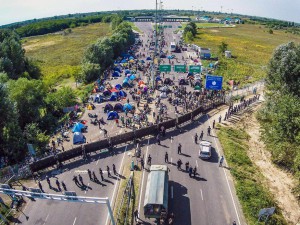
Fig. 1: Heavy clashes occurred between police and refugees this week at the border between Hungary and Serbia – Photo: AFP
The border closure itself, although it had been anticipated and although it seemed rather unspectacular when a freight car with barbed wire was placed in the last remaining gap of the fence on September 14, it nevertheless triggered a chain of events which did not predict a happy ending. The Hungarian government declared a state of emergency due to large-scale migration and the crisis at the borders, for which the legal basis had been created a few days prior to the border closure.[5] The camps were emptied and the (supposedly) last migrants put into special trains and dropped off in front of the Austrian border.[6] In combination with the actions of Orbán’s government, the German interior minister had signalled for another sequence of hectic reactions. On the day of Hungary’s border closure, controls began to be implemented at Bavaria’s border to Austria and the train connections were suspended with reference to the Oktoberfest in Munich. The German interior minister insinuated that the reintroduced border controls could become permanent.[7] However, it is important to emphasise that the borders of Germany were not closed, nor did a complete border closure occur in the ensuing months.
The confrontations in Röszke on September 15, the day after the Hungarian border closure, were brief but intense. Hungarian units shot water cannons and teargas at refugees who were trying to tear down the fence.[8] The following report by activists from Halle (Saale) is cited extensively, because it impressively illustrates the ambivalences of the events, fluctuating between militancy and despair:
The border is barred with a kind of palisade (fence and razor wire). Hungarian military officers are guarding their side of the crossing 24/7. Again and again, there are loud protests by refugees. But above all, there are many exhausted travellers: Thousands of people are sitting in the dark. Some with a tent, some with a sleeping bag, a blanket or a roll mat, many without anything. The only sleeping place is the cold floor. It is a shock for all of us – we did not expect this situation.
We had distributed all our material donations on the same evening within a short time frame. It only served for a fraction of the people present.
This is the beginning of a sequence of dramatic days and nights, which will appear like weeks in hindsight.
The next morning: The impressions from the previous evening are even worse in the daylight. This is a humanitarian catastrophe. Many people have been fleeing for weeks and are completely exhausted, among them are many elderly and sick people, as well as small children. The hygienic conditions are unbearable and most of the people we see have neither water nor nutrition, which is life threatening with a temperature of 35°C.
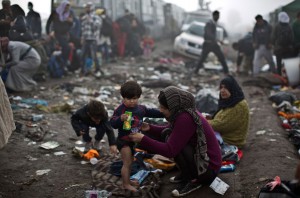
Fig 3: Picture sequence in the Zeit with the title ‚Final stop in Röszke‚
Neither the UNHCR nor other aid organisations are present, only MSF and a small Danish organisation have set up a medical tent. Thus, we start the attempt to provide – albeit minimal – basic necessities, together with a few helpers from other European countries and several refugees. A small empty customs office transforms into a hub for the collection and distribution of material donations, water and food. In front of the building, a field kitchen starts preparing hot food. Minimal medical aid is also among our activities, especially bandaging feet blistered from the long marches. During these treatments, we find time for intensive encounters with the people. Also with children, who often barely show any childlike impulses anymore. We also connect with Mahmud, a 15-year old basketball player from Damascus. He was playing for the Syrian national team and helps us with translations into Arabic during the ensuing days. Sadly we do not know where and how his journey continued.
The situation escalated in the afternoon. The special units of the Hungarian police, who are completely masked and who appeared next to the border guards in the morning, provoke confrontations with the refugees at the border. A water cannon shoots into the crowd – not only with water, but also with CS-gas. Now, the water previously organised for drinking has to be used for rinsing the eyes of the injured. Several people collapse, including a pregnant woman, mothers desperately search for their children lost in the smoke of the tear gas and the general turmoil, the injured are treated by paramedics. Three Serbian ambulances join to provide for the injured – but even these are targeted by the tear gas attacks of the Hungarian military. Our field kitchen and the material supplies are completely subsumed in this chaos, and the latter are no longer usable due to the tear gas. We try to save what can be saved and bring it to another empty building. And in all this chaos, there are the journalists focusing on capturing dramatic footage.
From Wednesday evening onwards and in the course of Thursday, the site is already emptying again. People are brought to the first official UNHCR camp in Kanjiža, from where they can travel on to the Croatian border, probably to Bezdan or Šid, by coach (the tickets cost 25€, a price which has risen from the 20€ of the previous day). We had been warned about the Serbian police, but they were surprisingly calm and helpful during these processes. In contrast, the staff at the camp in Kanjiža rudely dismissed us from the site when we tried to get an impression of the situation in terms of provisions in the camp.[9]
These confrontations in Röszke on September 15 sent a strong signal of determination, a lasting warning to the security forces, even though the special units were eventually able to hold their positions. The clashes only lasted from noon until the evening – not only due to the presence of Hungarian special units and the draconian punishments threatened in cases of damage to the border infrastructure, but also because of the numerous gaps in the fence in other sites away from clashes.
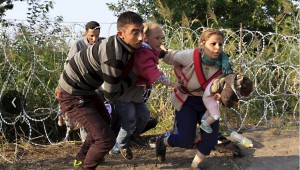
Fig 4: Picture from http://www.zeit.de/politik/ausland/2015-08/flucht-grenzzaun-ungarn
While the last refugees crawled through under the fence between Serbia and Hungary, while children and babies were lifted across the fence, and while others were trying their luck at the border post itself, Serbia deployed buses to transport people away from the site and towards Croatia. In this way, Serbia refused to become complicit with Hungary’s isolationist policy. The refugees arriving from Presevo were rerouted to Sid – but without consideration for the limited capacities of neighbouring Croatia.
An interim report, connected to a call-out for support, was spread by No Border Serbia:
The situation is changing rapidly, it is very chaotic and hard to follow what is going on. After the brutal police attack at Horgos almost all people left to Croatia. Approx. 100 people stayed there waiting for a chance to cross. There are 21 persons in prison in Hungary who were arrested at Horgoš when they broke through the gate. We don’t know the exact accusations but probably they‘ll try to criminalize them in the worst way. If anybody can do something, they need international support![10]
The minefields remaining from the Yugoslav war had not been removed in Croatia. Serbia and Croatia had maintained a hostile attitude towards each other for years, implying that their removal had not been deemed necessary. Nonetheless, the Croatian government initially responded positively and showed its willingness to dissociate itself from the Hungarian cruelty:
Hungary closed its borders, now the refugees are searching for new routes to Europe. Thousands of people want to travel to Western Europe via Croatia. They start the journey on foot – but the route is dangerous, because the Croatian soil is still contaminated with thousands of land mines from the Balkan conflict, especially in the border regions. Now the Croatian authorities are responding and, according to the news agency Reuters, are sending demining equipment to the Serbian border.[11]
In addition, the taz reported:
Croatia wants to allow refugees to transit to Western Europe, in contrast to Hungary. As prime minister Zoran Milanovic announced on Monday before parliament: The refugees „are allowed to pass through Croatia and we are working hard to make this possible“. He added: „We are willing to accept and to guide these people“. 150 people had already come to Croatia to circumvent the closed Hungarian border.[12]
Instead of 150 people, 8000 arrived on the next day. The Serbian bus connections no longer led from Presevo to Belgrade and Subotica, but a direct bus connection was installed from Presevo across the country to Sid. From Sid, the route continued for 10km on foot until the Croatian border site Tovarnik. A group of several hundred migrants broke through the Croatian barriers and pushed to the train station of Tovarnik, where the people initially had no option but to camp outside.[13]
A colleague, who was present in Tovarnik, a Croatian village near the Croatian-Serbian border, described the situation as a humanitarian disaster. According to her estimates, at least 2.000 refugees were staying at the train station, and just as many in the village itself. However, the Croatian police blocked the access to the village, meaning that the refugees, including many children and elderly people, were forced to endure at the train station for days.[14]
The group from Halle reports on the intolerable conditions at Tovarnik station:
The train standing in the train station since the afternoon is completely overloaded. There was intense turmoil already during the afternoon, when the waiting groups realised that only some of them would be able to continue their journey by this means of transport.
In one of the waggons, it is not possible to open the window and the air conditioning is not working, consequently the oxygen ratio inside is decreasing rapidly. The windows are already misted up and people are banging on the windows from the inside. We realise the scope of the catastrophe and intervene – as both doors are blocked by Croatian police officers preventing people from exiting the train.
In the same night, further tragic scenes occur in the village of Tovarnic itself. Several buses arrive in the middle of the night. The police orders women and children to board the buses first and many families are separated in the process. A man reports that he has lost his family for the third time within just two weeks and again does not know where they are. Refugees are not told where they are going, neither when boarding the trains nor during the distribution into buses.
As many people do not receive a place in the bus, several hundreds left behind have to spend the rest of the night sleeping on the street. We wrap our last ten blankets around children and babies who are lying on the bare ground.[15]
Some of the Serbian buses drive past Sid to the Croatian border town Bapska. From there, it is 20km by foot until the transit camp hastily erected in an old oil factory near the village of Opatovac. Again the report from the activists from Halle:
We are on the road until the late morning hours, distributing food out of the car window and trying to give the people energy: it is not far, we tell them. We see many people who can hardly stand up on their feet anymore. They carry all their belongings with them, some leave their bags behind due to exhaustion and continue only carrying themselves. The road carries on unendingly for the overtired and undernourished people. Again and again, we are asked how much of the way is left. According to reports, the distance between the arrival point of the buses and Opatovac is 20 kilometres.
When drawing interim conclusions about these days between September 14 and 17, it is important to record not only the misery described here, but also that the concerted actions coordinated between Serbia and Croatia prevented that the migrants got lost in the minefields. These days were hectic not only on the streets beyond Sid, but also on a diplomatic level. Zagreb protested against Belgrade and Budapest, and the Pope called for mercy.[16] However, after three anxious days, Zagreb adjusted to the new situation – in an unpredictable way: on Friday 18 September and in the following night, thousands of migrants were brought to different unsecured parts of the border in trains and buses and escorted to the Hungarian border. In the ensuing four weeks, a sort of state-organised assistance developed, which is described in more detail in the next chapter. Around one hundred special trains and multiple buses were deployed. This put the Orbán-government back into a defensive position after four days, and it had no choice but to resort to the same tactics as the Croatian government. Henceforth, without any further registration, three or four special trains per day transported the migrants to the Austrian border to the Hegyeshalom-Nickelsdorf border crossing.
However, the events in Röszke also led to a generalised opinion among security forces, which spread across mutually hostile countries: the movement of migrants could not be halted, unless at a very high and internationally despised price – but it could be possible to develop a disciplinary regime to control and steer the ‚flow‘. Military units were deployed, armoured tanks arrived to intimidate the migrants, rituals of submission were performed: building barricades, forcing refugees to sit on the floor, letting them starve, lining them up in rows of two, cattle-driving Yalla Yalla cries and many similar scenarios. The following pictures from Opatovac, taken by activists from Northern Germany, illustrate the previous commentary.
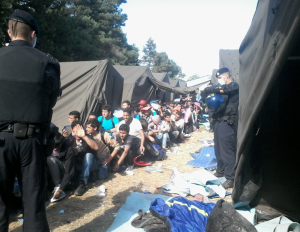
Fig. 7: Opatovac
The activists were not only observing the authorities taking pictures of each other in victory position in front of the migrants sitting on the floor, but they were also documenting the demonstrations of dignity by those subjected to the disciplinary regime, illustrated and remembered through the pictures below. The text on the signs is almost unreadable, because the ink in the pen was finishing.
[1] http://ffm-online.org/2015/06/18/ungarn-eu-zaun-gegen-serbien/
[2] http://ffm-online.org/2015/09/11/ungarn-mobilisiert-tausende-soldaten-fuer-zaunbau/
[3] http://derstandard.at/2000021485062/Ungarn-will-Fluechtlinge-an-Grenze-internieren
[4] http://www.berliner-zeitung.de/politik/eu-aussengrenze-wie-ungarn-den-fluechtlingsstrom-aufhaltenwill,10808018,31630258.html
[5] http://www.faz.net/aktuell/politik/fluechtlingskrise/fluechtlinge-suchen-sich-neuen-weg-nach-europa-13803713.html. An overview on the activities of the Orbán government until 1st October is available on Pester Lloyd: http://www.pesterlloyd.net/html/153newsticker2.html.
[6] http://www.theguardian.com/world/2015/sep/14/hungary-refugees-austria-border-clampdown
[7] http://ffm-online.org/2015/09/14/deutschland-macht-dicht-vor-dem-oktoberfest/
[8] For videos of the scenes, see: http://ffm-online.org/2015/09/17/bilder-von-der-serbisch-ungarischen-grenze/, for a blog description, see: http://pesterlloyd.net/html/1538ausschreitungen.html
[9] http://ffm-online.org/2015/10/28/entlang-der-balkanroute/
[10] https://noborderserbia.wordpress.com/
[11] http://www.spiegel.de/politik/ausland/kroatien-schickt-minenraeumer-an-grenze-zu-serbien-a-1053148.html
[12] http://www.taz.de/Kroatiens-Umgang-mit-Fluechtlingen/%215233702/
[13] http://nos.nl/artikel/2058240-honderden-vluchtelingen-breken-door-barricade-in-kroatie.html
[14] http://bordermonitoring.eu/verein/2015/09/kurzbericht-von-der-kroatisch-serbischen-grenze/
[15] http://ffm-online.org/2015/10/28/entlang-der-balkanroute/
[16] http://www.dw.com/de/kroatien-schiebt-tausende-fl%C3%BCchtlinge-nach-ungarn-ab/a-18724091?maca=de-rss-de-news-1089-xml-mrss

